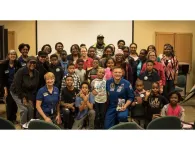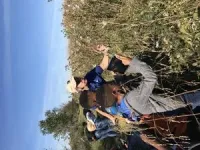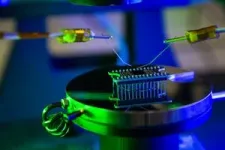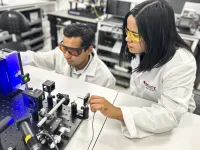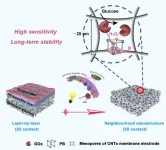(Press-News.org) The results of a yearlong science program show that one of the best ways to instill a lasting interest in science among children is to engage them alongside their family members. This finding runs counter to the current framework, in which children attend science-related summer camps and after-school programs apart from their families, diminishing the long-term potential of what they learn.
“We wanted to see if we could support families as a whole, as opposed to giving a student a really amazing one-off experience and sending them home to parents who potentially aren’t familiar with the content or don’t know how to help them pursue classes they could take on the subject,” said lead author Megan Ennes, assistant curator of museum education at the Florida Museum of Natural History.
In partnership with North Carolina State University and with funding from the National Science Foundation, the authors based their study on a family science program hosted at three museums. Over the course of 10 months, families met on weekends for science-themed events, beginning each day with a communal meal.
Afterward, the cohort participated in hands-on activities and attended an information session led by professionals with careers in science, technology, engineering or mathematics (STEM), giving families first-hand accounts of what it’s like to work in those fields. A local teen coding club demonstrated the nuances of programming by having families construct a Rube Goldberg machine in one session, and an astronaut visited to discuss the promise and perils of space travel in another.
During an event with a focus on local wildlife, an ornithologist helped families capture birds with mist nets, banding individuals that hadn’t been caught before to monitor their populations. These formative activities were strengthened by shared experience.
“After the bird banding, one of the parents bought a feeder so they could continue talking about birds at home,” Ennes said. “Our goal wasn’t to convince students to become scientists, because not everyone wants that. But if we can help families see science as something they do for fun together, then we can help ensure they have a lifelong engagement with it.”
The museums intentionally recruited families from low socioeconomic backgrounds, including groups that have been historically underrepresented in STEM careers. According to a 2018 report by the Pew Research Center, 11% of jobs in the U.S. are held by African Americans, compared with only 9% in STEM. The gap is even wider among Hispanics and Asians, who respectively make up 16% and 17% of the workforce but hold only 7% and 10% of STEM jobs.
The authors also focused the program’s content and activities toward elementary school students, who are often more perceptive of the natural world around them than their older peers.
“Most kids have an innate interest in science,” Ennes said. “For them, it’s about curiosity and wonder, but research shows that as they make their way through middle school, there’s a significant decline in who remains interested and chooses to take optional science classes in high school. So we wanted to focus on upper elementary school, where children still have that curiosity, so that we could build a support system around it.”
Children who participated in the program were more likely to envision themselves as scientists in the future than the students in the control group, who attended regular after-school programs during the same time period. Program participants also increasingly saw science as something they’d continue to use and engage with in the future, compared with children in the control group, whose perception of the importance of science waned throughout the year.
And despite the focus on younger students, the programs benefits also extended to other family members. Through exit surveys and personal correspondence, the authors noted that families began visiting other museums in their free time, and the program sparked or renewed an interest in science in siblings and parents.
“By designing programs for the family we are able to build in extended support for STEM interests,” said study co-author Gail Jones, alumni distinguished graduate professor of science education at North Carolina State University. “Our families reported changing holiday gifts to include more gifts that build STEM interests; they reported spending more time exploring science together at home; and they sought out new experiences for STEM in their community.”
One parent told Ennes that their seventh-grade student had failed their science classes through most of their schooling. After engaging in science activities with their family for a year, the student not only brought their grade up to an A but received an award for academic achievement from their school as well. A sibling from another family applied to become a museum volunteer, and three parents made the decision to go back to school and potentially obtain a degree in science.
Scientists are often portrayed as lone mavericks who make ground-breaking discoveries, but according to Ennes, engaging as a community is much closer to how scientists actually operate.
“Some of the greatest challenges and opportunities our society is faced with will be solved by teams rather than by individuals,” she said. “Helping families see science as something they do together with a community can help build 21st-century skills needed to be successful in science and society, such as collaboration and flexibility. It also builds a supportive network to allow youth and families to explore new careers and lifelong hobbies related to science.”
The study was published in the journal Research in Science Education.
END
It takes a village: Study shows community is key to a sustained passion for science among adolescents
2023-06-14
ELSE PRESS RELEASES FROM THIS DATE:
Racial disparities found in one of first studies of pharmacological treatment of insomnia
2023-06-14
INDIANAPOLIS — In one of the first studies to investigate racial disparities in the pharmacologic treatment of insomnia, researchers from Regenstrief Institute and Indiana University report that patients belonging to racial minority groups were significantly less likely to be prescribed medication following diagnosis of insomnia than White patients.
The study found that Black patients were much less likely to have been prescribed an FDA-approved insomnia medication at any time post diagnosis than White patients. Other non-White individuals were significantly less likely to be prescribed an FDA-approved medication two, three, and four years after insomnia diagnosis ...
New York Academy of Sciences, Leon Levy Foundation name first 10 Leon Levy Scholars in Neuroscience
2023-06-14
New York, NY, June 14, 2023 — The New York Academy of Sciences and the Leon Levy Foundation announced today the first cohort of Leon Levy Scholars in Neuroscience; a continuation of an earlier fellowship program started by the Foundation in 2009 that has supported 160 fellows in neuroscience.
This highly regarded postdoctoral program supports exceptional young researchers across the five boroughs of New York City as they pursue innovative investigations in neuroscience and advance in their careers toward becoming independent principal investigators. Designed to broaden the field and to support researchers who might otherwise not ...
Cancer researchers focused on bringing new discoveries to patients get two-year funding awards
2023-06-14
June 14, 2023, TORONTO — Funding announced today by the Ontario Institute for Cancer Research (OICR) will help six Ontario-based research teams pursue their ultimate goal of improving the lives of people with cancer.
Funding comes through OICR’s Innovation to Implementation (I2I) program, which aims to help ensure new discoveries about preventing, diagnosing and treating cancer are adopted into healthcare policy and clinical practice.
“Every cancer researcher wants their work to have ...
Dr. Jonathan Weinsaft named chief of the Greenberg Division of Cardiology at Weill Cornell Medicine and NewYork-Presbyterian/Weill Cornell Medical Center
2023-06-14
NEW YORK (June 14, 2023)— Dr. Jonathan Weinsaft, an esteemed physician-scientist who focuses on clinical research and cardiovascular imaging, has been appointed chief of the Greenberg Division of Cardiology at Weill Cornell Medicine and NewYork-Presbyterian/Weill Cornell Medical Center, effective July 1.
The Greenberg Division of Cardiology, housed within the Weill Department of Medicine, is dedicated to diagnosing and treating patients with disorders of the heart and blood vessels that comprise the cardiovascular system.
In his new role, Dr. Weinsaft will further strengthen the division as a leader in scientific and technological ...
New diagnostic finds intact sperm in infertile men
2023-06-14
In a recent study, researchers created a diagnostic test to identify functional sperm in infertile men that could change the treatment of male infertility and assisted reproductive technology.
“Male infertility is a recognized issue and deserves scientific and clinical attention,” said Andrei Drabovich, an assistant professor of laboratory medicine and pathology at the University of Alberta and corresponding author of the Molecular & Cellular Proteomics study.
One in every six couples trying to conceive experience infertility issues. In fact, about 10% of men in the United States are infertile. The most ...
A novel technique to observe colloidal particle degradation in real time
2023-06-14
In the early 2000s, scientists from the UK made a worrisome discovery that the oceans are teeming with small particles of plastic (less than one millimeter in length) due to the continuous degradation of plastic waste. These microscopic particles of plastic have become a major environmental concern. Scientists classify these small particles as either microplastics or nanoplastics based on their size; the latter term is used exclusively for particles smaller than one micrometer.
These particles easily get embedded into the bodies of marine and freshwater animals, ...
Tiny device mimics human vision and memory abilities
2023-06-14
Researchers have created a small device that ‘sees’ and creates memories in a similar way to humans, in a promising step towards one day having applications that can make rapid, complex decisions such as in self-driving cars.
The neuromorphic invention is a single chip enabled by a sensing element, doped indium oxide, that’s thousands of times thinner than a human hair and requires no external parts to operate.
RMIT University engineers in Australia led the work, with contributions from researchers at Deakin University and the University of Melbourne.
The team’s research demonstrates a working device that captures, processes and stores visual ...
Solar cells can, finally, stand the heat
2023-06-14
SDE BOKER, Israel, June 14, 2023 – Photovoltaic technology is indispensable for our ability to mitigate climate change. Nonetheless, more than 70% of the energy made available to us by the sun is wasted in conventional photovoltaic cells. There is little hope for sustainable technological advancement without addressing this issue.
The operational temperature is a critical factor in a solar cell's ability to convert sunlight to free energy. Accordingly, much research has been directed toward understanding the temperature effects in the efficiency of photovoltaic solar cells. Surprisingly, ...
Scientists develop novel biosensing-membrane for glucose detection and monitoring
2023-06-14
Glucose oxidase (GOx)-based biosensors have attracted much attention for their potential in rapid glucose detection and continuous monitoring, which are crucial for disease diagnosis and prevention, as well as for controllable production in sugar-making and fermentation processes.
The glucose oxidase/electrocatalysts/electrode (GOx/ECs/electrode) cascade system serves as the core part of most glucose biosensing devices (both invasive and non-invasive). However, patterned assembly of these cascade sensing units remains challenging, thus limiting the ...
Improving word intelligibility of bone-conducted speech using bone-conduction headphones
2023-06-14
Ishikawa, Japan -- Bone-conduction (BC) headphones enhance hearing capability by generating vibrations in bone or skin close to the ear, including the regio temporalis. They simultaneously leave the ear canal open to allow the surrounding air-conducted (AC) sounds for normal hearing. However, word intelligibility – recognition ability – is often poor during bone-conducted speech perceived using BC headphones due to the attenuation of its high-frequency components, especially under noisy conditions. While inserting ear plugs in the ear canal help improve ...
